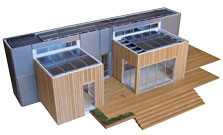

Carnegie Mellon's "plug and play" design allows the house to be upgraded with larger or smaller rooms.
Download Construction Drawings
(Zip 16 MB)
Neither the United States, nor the Department of Energy, nor the Alliance for Sustainable Energy LLC, nor any of their contractors, subcontractors, or their employees make any warranty, express or implied, or assume any legal liability or responsibility for the accuracy, completeness, or usefulness for any purpose of any technical resources or data attached or otherwise presented here as reference material.
Solar Decathlon 2007
Carnegie Mellon University
Plug and Play House
Much like adding a new "plug and play" device to a computer, the Carnegie Mellon home can be upgraded with smaller or larger rooms. All the rooms are arranged around the home's central core, which contains all the home's mechanical systems. Connections to mechanical supports are installed in the core and are easily accessible and adjustable.
"We want to encourage the housing industry to use our design system to create homes that families can design around their needs and change them as their needs change, like when they have a new baby or empty nest," said student Ben Saks.
The plug and play design works well with solar energy technologies, too. These include a daylighting design that reduces the need for electrical lighting; a 6.88-kW solar electric system on the roof; and a solar water heating system located above the bathroom.
Sustainable materials such as high-efficiency insulation and native white oak from Pennsylvania for the exterior were used as much as possible. To reinforce the sustainable living message, a "greenscape" composed of plants was added to provide insulation. It literally grows from the land, up the walls, and onto the roof, where the plants keep the home cool in summer.
A common space connects the Carnegie Mellon home with the home of the Decathlon team from Germany, softening the edges of the house and reinforcing the sense of community and neighborly interaction.
"This solar home is a fantastic educational tool for the public and the team," says student Rosemary Lapka. "I can't get the hands-on experience in the classroom I get working on this project. I work with real people, real time tables, and real budgets. It makes it very educational."
Carnegie Mellon worked with two other universities on this project. The Art Institute of Pittsburgh helped students design the furniture. The University of Pittsburgh helped with construction and will install the house permanently after the event in the Powder Mill Nature Reserve, an outdoor educational center affiliated with the Carnegie Museum of Natural History.
Team Contact
Stephen Lee
stevelee@andrew.cmu.edu
